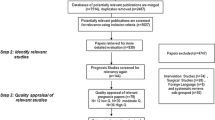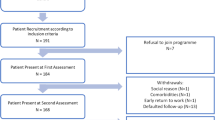Abstract
Purpose
To reduce the socio-economic burden of persistent low back pain (LBP), factors influencing the progression of acute/subacute LBP to the persistent state must be identified at an early stage.
Methods
Prospective inception cohort study of patients attending a health practitioner for their first episode of acute/subacute or recurrent LBP. Patients were assessed at baseline addressing occupational, psychological, biomedical and demographic/lifestyle factors and followed up over 6 months. Multivariate logistic regression analysis was performed separately for the variables groups of the four different domains, controlling for age, gender and body mass index. The overall predictive value was calculated for the full regression models of the different domains. Finally, all significant variables from the different domains were combined into a final predictor model.
Results
The final four-predictor model predicted 51 % of variance of persistent LBP and included ‘resigned attitude towards the job’ (OR 1.73; 95 % CI 1.16–2.59), ‘social support at work’ (OR 0.54; 95 % CI 0.32–0.90), ‘functional limitation’ (OR 1.05; 95 % CI 1.01–1.10) and ‘duration of LBP’ (OR 1.04; 95 % CI 1.02–1.06). The accuracy of the model was 83 %, with 92 % of non-persistent and 67 % of persistent LBP patients correctly identified.
Conclusions
In this study of patients with acute/subacute LBP, ‘resigned attitude towards the job’ increased the likelihood of persistent LBP at 6 month. Addressing this factor with workplace interventions has the potential to modify the outcome. In patients experiencing ‘social support at work’, the development of persistent LBP was less likely and might therefore be considered as potential resource for prevention of persistent LBP.

Similar content being viewed by others
References
Airaksinen O, Brox JI, Cedraschi C, Hildebrandt J, Klaber-Moffett J, Kovacs F, Mannion AF, Reis S, Staal JB, Ursin H, Zanoli G (2006) Chapter 4. European guidelines for the management of chronic nonspecific low back pain. Eur Spine J 15 Suppl 2:S192–S300
Balague F, Mannion AF, Pellise F, Cedraschi C (2007) Clinical update: low back pain. Lancet 369(9563):726–728
Bossuyt PM, Reitsma JB, Bruns DE, Gatsonis CA, Glasziou PP, Irwig LM, Lijmer JG, Moher D, Rennie D, de Vet HC (2004) Towards complete and accurate reporting of studies of diagnostic accuracy: the STARD initiative. Fam Pract 21(1):4–10
Dunn KM, Jordan K, Croft PR (2006) Characterizing the course of low back pain: a latent class analysis. Am J Epidemiol 163(8):754–761
Elfering A (2006) Work-related outcome assessment instruments. Eur Spine J 15(Suppl 1):S32–S43
Elfering A, Mannion AF (2008) Epidemiology and risk factors of spinal disorders. In: Boos N, Aebi M (eds) Spinal disorders—fundamentals of diagnosis and treatment. Springer, Berlin Heidelberg, New York, pp 153–173
Elfering A, Semmer NK, Schade V, Grund S, Boos N (2002) Supportive colleague, unsupportive supervisor: the role of provider-specific constellations of social support at work in the development of low back pain. J Occup Health Psychol 7(2):130–140
Elfering A, Dubi M, Semmer NK (2010) Participation during major technological change and low back pain. Ind Health 48(3):370–375
Fairbank JC, Pynsent PB (2000) The oswestry disability index. Spine 25(22):2940–2952 (discussion 2952)
Heneweer H, Aufdemkampe G, van Tulder MW, Kiers H, Stappaerts KH, Vanhees L (2007) Psychosocial variables in patients with (sub)acute low back pain: an inception cohort in primary care physical therapy in The Netherlands. Spine 32(5):586–592
Hilfiker R, Bachmann LM, Heitz CAM, Lorenz T, Joronen H, Klipstein A (2007) Value of predictive instruments to determine persisting restriction of function in patients with subacute non-specific low back pain. Systematic review. Eur Spine J 16(11):1755–1775
Kälin W, Semmer N, Elfering A, Tschan F, Dauwalder J, Heunert S, Crettaz F (2000) Work characteristics and well-being of Swiss apprentices entering the labor market. Swiss J Psychol 59(4):272–290
Katz JN (2006) Lumbar disc disorders and low-back pain: socioeconomic factors and consequences. J Bone Jt Surg Am 88(Suppl 2):21–24
Linton SJ (2001) Occupational psychological factors increase the risk for back pain: a systematic review. J Occup Rehabil 11(1):53–66
Mannion AF, Elfering A (2006) Predictors of surgical outcome and their assessment. Eur Spine J 15(Suppl 1):S93–S108
Melloh M, Aebli N, Elfering A, Roder C, Zweig T, Barz T, Herbison P, Hendrick P, Bajracharya S, Stout K, Theis JC (2008) Development of a screening tool predicting the transition from acute to chronic low back pain for patients in a GP setting: protocol of a multinational prospective cohort study. BMC Musculoskelet Disord 9:167
Melloh M, Elfering A, Egli Presland C, Roeder C, Barz T, Rolli Salathe C, Tamcan O, Mueller U, Theis JC (2009) Identification of prognostic factors for chronicity in patients with low back pain: a review of screening instruments. Int Orthop 33(2):301–313
Ostelo RW, Deyo RA, Stratford P, Waddell G, Croft P, Von Korff M, Bouter LM, de Vet HC (2008) Interpreting change scores for pain and functional status in low back pain: towards international consensus regarding minimal important change. Spine 33(1):90–94
Pincus T, Santos R, Breen A, Burton AK, Underwood M (2008) A review and proposal for a core set of factors for prospective cohorts in low back pain: a consensus statement. Arthritis Rheum 59(1):14–24
Schade V, Semmer N, Main CJ, Hora J, Boos N (1999) The impact of clinical, morphological, psychosocial and work-related factors on the outcome of lumbar discectomy. Pain 80(1–2):239–249
Schmidt CO, Raspe H, Pfingsten M, Hasenbring M, Basler HD, Eich W, Kohlmann T (2011) Does attrition bias longitudinal population-based studies on back pain? Eur J Pain 15(1):84–91
Semmer N (2003) Individual differences, work stress, and health. In: Schabracq M, Winnubst J, Cooper C (eds) Handbook of work and health psychology, 2nd edn. Wiley, Chichester, pp 83–120
Semmer NK, Udris I (2007) Bedeutung und Wirkung von Arbeit. In: Schuler H (ed) Lehrbuch Organsationspsychologie, 4th edn. Huber, Bern, pp 157–195
Stanton TR, Latimer J, Maher CG, Hancock MJ (2011) A modified Delphi approach to standardize low back pain recurrence terminology. Eur Spine J 20(5):744–752
Steenstra IA, Verbeek JH, Heymans MW, Bongers PM (2005) Prognostic factors for duration of sick leave in patients sick listed with acute low back pain: a systematic review of the literature. Occup Environ Med 62(12):851–860
van Tulder M, Becker A, Bekkering T, Breen A, del Real MT, Hutchinson A, Koes B, Laerum E, Malmivaara A (2006) Chapter 3. European guidelines for the management of acute nonspecific low back pain in primary care. Eur Spine J 15 Suppl 2:S169–S191
Acknowledgments
This research was funded by the Wishbone Trust of New Zealand, Wellington; Lottery Health Research, Wellington; the Bruce McMillan Trust, Dunedin; the Dunedin School of Medicine; realHealth International; and the University of Berne. MM was funded by a scholarship awarded by the University of Otago. We gratefully acknowledge Kirsten Stout from the Centre for Musculoskeletal Outcomes Research (CMOR) at Dunedin School of Medicine, University of Otago, for developing and maintaining the documentation and data management system.
Conflict of interest
The authors declare that they have no conflict of interest.
Author information
Authors and Affiliations
Corresponding author
Rights and permissions
About this article
Cite this article
Melloh, M., Elfering, A., Chapple, C.M. et al. Prognostic occupational factors for persistent low back pain in primary care. Int Arch Occup Environ Health 86, 261–269 (2013). https://doi.org/10.1007/s00420-012-0761-9
Received:
Accepted:
Published:
Issue Date:
DOI: https://doi.org/10.1007/s00420-012-0761-9




